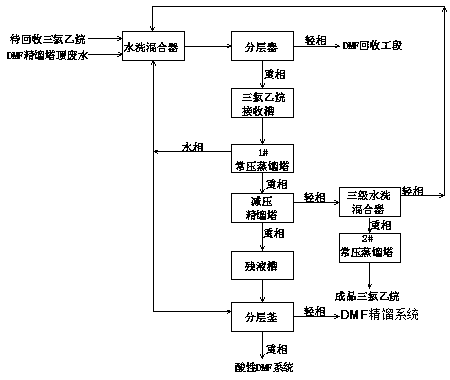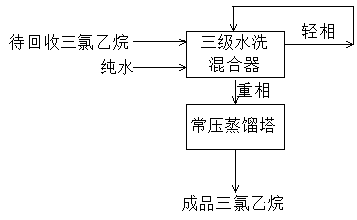Device and method for recycling trichloroethane in production of sucralose
A technology of trichloroethane and sucralose, which is applied in the preparation of sugar derivatives, sugar derivatives, and sugar derivatives, etc., can solve the problems of inability to recycle dilute DMF in wastewater, loss of recycling value, and complex wastewater components. , to achieve the effect of solving the large amount of waste water, reducing the consumption and protecting the environment
- Summary
- Abstract
- Description
- Claims
- Application Information
AI Technical Summary
Problems solved by technology
Method used
Image
Examples
Embodiment 1
[0021] (1). The trichloroethane to be recovered in the reservoir area and the waste water from the top of the DMF rectification tower are sent to the water washing mixer in a volume ratio of 4:1, and after being fully mixed, enter the stratifier and stand for 2 minutes to stratify. The obtained light phase (water phase) is sent to the DMF recovery section; the obtained heavy phase (containing trichloroethane) is sent to the trichloroethane receiving tank through pipelines;
[0022] (2). Then send trichloroethane into 1# atmospheric distillation tower at 4000~8000L / h, raise the temperature to 116℃, and return part of the water phase from the top of the tower to the washing mixer at 800L / h Apply mechanically, and all the rest are sent to the stratified kettle for water replenishment, and the heavy phase (trichloroethane phase) from the bottom of the tower enters the vacuum distillation tower;
[0023] (3). Control the vacuum degree of the vacuum rectification tower at -0.09MPa a...
PUM
 Login to View More
Login to View More Abstract
Description
Claims
Application Information
 Login to View More
Login to View More - R&D
- Intellectual Property
- Life Sciences
- Materials
- Tech Scout
- Unparalleled Data Quality
- Higher Quality Content
- 60% Fewer Hallucinations
Browse by: Latest US Patents, China's latest patents, Technical Efficacy Thesaurus, Application Domain, Technology Topic, Popular Technical Reports.
© 2025 PatSnap. All rights reserved.Legal|Privacy policy|Modern Slavery Act Transparency Statement|Sitemap|About US| Contact US: help@patsnap.com


